
|
HAKUHOO PERIOD BUDDHIST IMAGES |
|
Buddhist images of the Hakuho Period show a departure from the somewhat stiff feeling produced by the images of the earlier Asuka Period. The early Hakuho images typically have plump expressions reminding one of children, although under the continuing influence of Tang art. they develop into imposing pieces with adult bearing. Well-known and representative images of the period are the Buddha head from the Yamadadera with its boyish face. During this period in art history (i.e., Latter half of the 7th century), the techniques of sculpture developed greatly in the hands of craftsmen from among newly arriving continental immigrants. With the production of images in clay and dry lacquer. and with the appearance of Buddhist figures modeled from stone, cast on tiles, or hammered out on metal using reusable casts, there was a notable diversification in the types of materials employed. Also, there emerged during this period a richer diversity in modes of expression. with such works as Nyorai images seated on chairs and standing boddhisattvas with inclining waists.
Yumechigai Kannon, Horyuji
Amida Triad, known as Lady Tachibana's Triad (Horyuji)
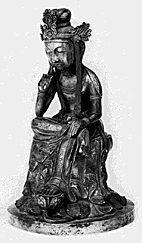
BOSATSU HANKAZO
|
|
SEMI-INCLINED BODDHISATTVA FIGURES (BOSATSU HANKAZO)IN BRONZE
During the Asuka and Hakuho Periods, there were produced many images of Miroku Bosatsu (the Boddhisattva Maitreya, sometimes rendered in English as "the Buddha of the future"). represented in a "halfinclined in meditation" posture. The illustration at the upper right is a Miroku Bosatsu image made in 666 in supplication for the recovery from illness of Empress Saimei. It is housed in the Yachuji (Osaka-fu, Habikino-shi). Although a Hakuho Period production, it retains much that is suggestive of Asuka Period imagery. The bosatsu hankazo shown in figure (e) below has a number of features characteristic of Buddhist imagery of the latter half of the 7th century. These include, for example, the delicate facial features; the type of head ornament known as sanmen toshoku, and the generous size of the lotus petals at the base. It is said to have been originally housed within the body of the Nyoirin Kannon which is the main object of worship at the Okadera.
|
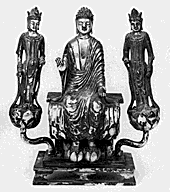
Amida triad bearing inscription "image belonging to Lord Yamada" (possibly Soga-no-Kurayamada Ishikawamaro). It forms part of the Shijuhattai-butsu.
|
|
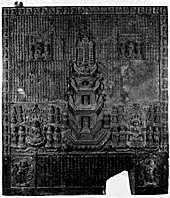
HOKKE SESSOZU
Sakurai-shi, Hasedera
This Is a cast metal plaque with a scene of Shaka delivering a sermon. I n such features as the miniature stamped Buddha images (oshidashibutsu) attached to parts of the surface, and the hairline engravings of heavenly attendants (tennin) around the lower edge, one sees that a variety of metalworking techniques were imaginatively and skillfully employed. I n its lower section,there is an inscription to the effect that it was made for the emperor In the "year of the dog" (in this case, either 686 or 698) by the priest Domyo and colleagues. According to some accounts, this bronze plaque was originally emplaced as an object of worship in a stone chamber or grotto on a hill west of the Hasedera.
|
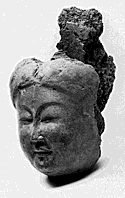
|
|
CLAY FIGURES
The variety in the types of materials used for Buddhist images in the Hakuho Period is reflected in many forms, including the clay figures (sozo) which have been unearthed from the sites of Asuka temples. Such figures were produced by applying clay to a wooden core and were then finished by the addition of surface coloring. Besides the famous clay productions from the 8th century Which have been handed down In the Horyuji, Todaiji and Kofukuji, earlier clay figures from the 7th century have been found in Asuka. at such locations as the hill behind the Kawaradera, the Tachibanadera, the Tachibedera and the Moto Yakushiji.
Clay figure unearthed on hill behind Kawaradera.
|
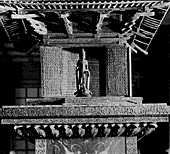
|
|
Tamamushi miniature shrine at the Horyuji.
The interior walls and shutters, decorated with embossed Buddhist images (oshidashibutsu) on gilt bronze foil, give an idea of the way full-scale rooms ornamented with senbutsu must have looked.
|
|
TENNIN-SEN AND HOO-SEN
7th century Okadera and Minami Hokkeji
In addition to the brick-Like tiles (sen) from the Hakuho Period which depict images of the Buddha, there remain two others, both at one time in the possession of the Okadera, depicting a tennin (heavenly attendant) and a hob (phoenix-like mythical bird),respectively.
An intricately constructed senbutsu fragment (see illustration, page 77) unearthed from the site of an abandoned temple at Natsumi, Mie-ken, shows miniature sen ornamented with figures of tennin, worshippers, incense burners and lions, surrounding the base of a shumidan (platform for a Buddhist image).The extant tennin-sen and hoooo-sen were perhaps used in the same way around the base of a full-scale shumidan.
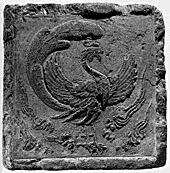
hoooo-sen
|
|
RYOKUYU HAMON-SEN
7th century Kawaradera
These are fragments of tiles covered with green glaze and showing wave patterns (hamon) in relief. They were probably spread atop platforms (shumidan) for Buddhist objects inside temple halls and meant to represent "lotus ponds of the pure land," similar to the lotus pond depicted under the Buddhist images within the Tachibana miniature shrine at the Horyuji. In Japan, these are the oldest extant baked clay objects which are coated with green glaze (ryokuyu).
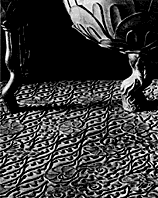
Lotus pond of the Tachibana
miniature shrine
|
|Asuka Period
|THE ASUKA PALACES
|ASUKA STONES
|ASUKA KOFUN|
|TAKAMATSUZUKA KOFUN
|THE ASUKA TEMPLES
|ASUKA AND THE MAN'YOSHU|
Copyright (c) 1995 ASUKA HISTORICAL MUSEUM All Rights Reserved.
Any request to kakiya@lint.ne.jp
Authoring: Yasuhito Kakiya
|